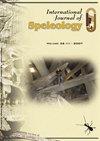德国西北部b7洞两个石笋的镁记录表明全新世早期至中期的长期降水变化
IF 1.3
4区 地球科学
Q3 GEOSCIENCES, MULTIDISCIPLINARY
引用次数: 1
摘要
利用多收集器电感耦合等离子体质谱(MC-ICPMS) 230 / u定年技术,对德国西北部b7洞穴的两根石笋进行了重新定年,该洞穴与被广泛研究的邦克洞穴属于同一洞穴系统。此外,采用激光烧蚀电感耦合等离子体质谱(LA-ICPMS)高分辨率测定了Mg、Sr、Ba、P、Y、Zn和Al的浓度。石笋B7-1生长于10.8 ~ 5.8 ka BP。石笋B7-7的生长经历了11.0 ~ 6.2、3.13 ~ 2.86(青铜时代晚期)和1.27 ~ 1.15 ka BP(中世纪早期)三个生长阶段。铝作为碎屑物质的代用品,与石笋B7-1可见碎屑层和石笋B7-7最老生长期对应良好。石笋B7-7的两个年轻生长阶段非常干净,Al浓度很低。磷、Y、Zn在石笋各生长阶段均呈显著正相关,但与温度、降水关系不显著。这可能与两种石笋中较高的碎屑含量有关。在石笋的各个生长阶段,钡和锶也表现为正相关,这与它们对生长速率的依赖性有关。镁最有可能受到先前方解石降水的影响,因此是过去降水/入渗的代表。B7-1石笋和B7-7石笋最老生长期的Mg记录显示,在全新世早期至中期,Mg浓度随时间的变化呈递减趋势,反映了方解石前期降水的减少,从而导致降水的增加。这与中欧的其他气候重建结果一致。本文章由计算机程序翻译,如有差异,请以英文原文为准。
Mg records of two stalagmites from B7-Cave (northwest Germany) indicating long-term precipitation changes during Early to Mid-Holocene
Two stalagmites from B7-Cave in northwest Germany, which is part of the same cave system as the intensively studied Bunker Cave, were re-dated by multi collector inductively coupled plasma mass spectrometry (MC-ICPMS) 230Th/U-dating. Furthermore, the concentration of Mg, Sr, Ba, P, Y, Zn, and Al were determined at high-resolution by laser ablation inductively coupled plasma mass spectrometry (LA-ICPMS). Stalagmite B7-1 grew from 10.8 to 5.8 ka BP. Stalagmite B7-7 grew during three growth phases from 11.0 to 6.2, 3.13 to 2.86 (late Bronze Age), and 1.27 to 1.15 ka BP (early Medieval Period). Aluminium is a proxy for detrital material and corresponds very well with the visible detrital layers in stalagmite B7-1 and the oldest growth phase of stalagmite B7-7. The two younger growth phases of stalagmite B7-7 are very clean and show very low Al concentrations. Phosphorus, Y, and Zn show positive correlations in both stalagmites and all growth phases, but do not show a relationship to temperature or precipitation. This may be related to the elevated detrital content in both stalagmites. Barium and Sr also show a positive correlation in both stalagmites and all growth phases, which is related to their dependency on growth rate. Magnesium is most probably influenced by prior calcite precipitation and therefore a proxy for past precipitation/infiltration. The Mg records of stalagmite B7-1 and of the oldest growth phase of stalagmite B7-7 show decreasing Mg concentration with time reflecting decreasing prior calcite precipitation and therefore increasing precipitation during the Early to Mid-Holocene. This is consistent with other climate reconstructions from Central Europe.
求助全文
通过发布文献求助,成功后即可免费获取论文全文。
去求助
来源期刊

International Journal of Speleology
地学-地球科学综合
CiteScore
3.10
自引率
23.10%
发文量
12
审稿时长
>12 weeks
期刊介绍:
The International Journal of Speleology has the aim to get cave and karst science known to an increasing number of scientists and scholars. The journal therefore offers the opportunity to all scientists working in and on karst to publish their original research articles or their review papers in an open access, high quality peer reviewed scientific journal at no cost. The journal offers the authors online first, open access, a free PDF of their article, and a wide range of abstracting and indexing services.
 求助内容:
求助内容: 应助结果提醒方式:
应助结果提醒方式:


